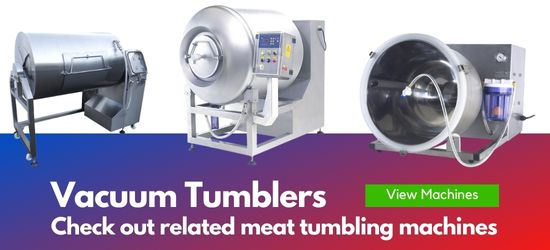Vacuum tumbling is a specialized process for marinating meet that results in the maximum saturation of the spices and brine into the meat. This process can be performed at a domestic level as well as on a commercial scale. Commercial vacuum tumblers range from smaller table top units, used in test kitchens and smaller restaurant applications to machines that vacuum tumble or massage loads of 5000 pounds or more at one time. Vacuum tumbling has become a popular process and the resulting meat products have become very desirable for both meat processors as well as consumers. Meat processors like the fact that the finished meat products weigh more than the original non vacuum tumbled products and that added weight is in the form of a liquid that will allow the product to remain moister after the cooking process is completed as well as taste better. Consumers find the more flavorful product achieved without extra work on their part to be highly desirable.
How does Meat Vacuum Tumbling Work?
The meat industry tends to refer to all different types of meat products as proteins. When any protein is subjected to a vacuum the pores in that protein expand. This expansion allows the marinade being used in the vacuum tumbling process to penetrate deeper into the protein at a much faster rate than soaking a protein in a marinade can accomplish. All vacuum meat tumbling machines utilize a drum that contains both the protein being marinated and the marinade being used. Once all the ingredients are in the drum the drum is sealed and a vacuum is applied to the drum. The type of machine used will determine if the tumbling process begins while the vacuum is being applied or after the desired vacuum level is achieved. If you look inside the drum you would see fins these fins lift and then drop the product in the drum and this action helps achieve not only the marinating but also breaks down muscle in the product resulting in a tenderer product after the process is completed.
As mentioned above there are two basic types of meat vacuum tumbling machines. One is referred to a non-continuous system and the other as a continuous system. The major difference being how the vacuum is applied. In a non-continuous system the vacuum source is connected externally to the drum and once the desired vacuum level inside the drum has been achieved the vacuum source is disconnected from the drum and then the tumbling process can begin. The continuous system utilizes a snorkel mounted inside the drum and connected to the vacuum source to provide the desired vacuum level inside the drum. The continuous system has several advantages however the cost of continuous models are higher. Most continuous models have control systems that allow the process to include release of vacuum pressure, short rest times from tumbling and then re-introduction of the vacuum pressure. These actions cause a sponge effect on the product and that results in even higher saturation rates of the marinade. The continuous systems have been the standard of the industry in Europe for many years while the non-continuous system have always been more popular in the USA due to simple operation and lower machine cost.
Benefits of Vacuum Meat Tumbling Machines
Meat vacuum tumbling machines offer many benefits for both processors and consumers. Some of these benefits are:
- Greater weight of the un-cooked product
- A moister product after cooking
- A better tasting product
- A tenderer product
- Less wasted marinade compared to a soaking process
- A more completely marinated product can be achieved in about one hour vs. 24 hours of static soaking.
